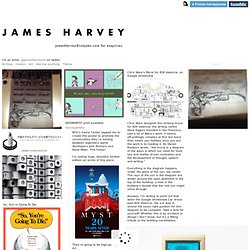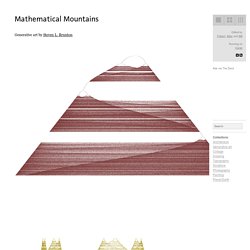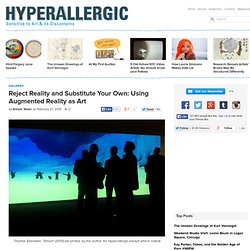

James Harvey. Chris Ware designed this striking mural for 826 Valencia, the writing centre Dave Eggers founded in San Francisco.

Like a lot of Ware’s work, it seems off-puttingly complex at first but more than meets you halfway once you put the work in to reading it. As Daniel Raeburn wrote, “the mural is a diagram of the ways in which our need for food, sex and shelter drives civilisation and the development of thought, speech and writing.” Everything in the diagram happens under the glare of the sun, top center.
The rays of the sun in the diagram are drawn around the open pediment in the top of the building- a hole in the building’s facade that the real sun might shine through. Anyway, I’m writing to point out that when the Google Streetview Car drove past 826 Valencia, the sun was in almost the exact right position for this diagram to be complete.
Mathematical Mountains. Generative art by Steven L.

Brunton Steven explains: These images are excerpts from the bifurcation diagrams of various one-dimensional maps, including the logistic map [third from top], the hat map [second from bottom], and the cosine map [top image]. Each of these dynamical systems model various physical phenomena in the real world. For example, the logistic map is a crude model of population dynamics with reproduction and limited resources, and it is often used as an example of the period-doubling route to chaos. The Useless Web.
Guiquimi - Centro de Cultura Digital - Mexico. Open & Digital Culture. Art and Electronic Media. PressPausePlay. Seaquence. Escape Into Life. A blog about art and visual ingenuity. A blog about art and visual ingenuity. Digital Art, Design and Culture. Oneohtrix Point Never - Still Life (Betamale) Digital Art, Design and Culture. Zolloc. Beatgram. Archivos sobre un lienzo digital >> El arte en la edad del silicio. "File_Món" de César Escudero y los tanques en la plaza de Tiananmen.

Cada ordenador encierra un mundo de archivos. Cada uno de ellos puede ser al mismo tiempo un oscuro y anónimo icono o un valioso recuerdo personal, según las perspectivas y todos ellos en su conjunto pueden percibirse como un inestimable caudal de memorias o tan solo un montón de archivos. César Escudero Andaluz, uno de nuestros artistas más internacionales en el ámbito de las arte digitales, que ha bautizado su mundo de archivos File_Món, asegura no haber reparado nunca en la similitud con la palabra mundo (món) en catalán y prefiere la irónica referencia al comic de Francisco Ibáñez. CreativeApplications.Net.
HOME - DATABASE OF VIRTUAL ART - DATABASE OF VIRTUAL ART - DATABASE OF VIRTUAL ART. Reject Reality and Substitute Your Own: Using Augmented Reality as Art. Thomas Eberwein, “Ghost” (2013) (all photos by the author for Hyperallergic except where noted) Whether you like it or not, the digital invasion of Google Glasses is on its way, bringing the alternate world of augmented reality with it.

As the late sci-fi author Philip K. Dick, who I really wish was here to react to the rapidly cyborg-like technology advances, forebodes in his 1978 essay “How to Build a Universe That Doesn’t Fall Apart Two Days Later“: What is real? Because unceasingly we are bombarded with pseudorealities manufactured by very sophisticated people using very sophisticated electronic mechanisms. Mark Mussler, Happy Pets, Thibaut Brevet, Cem Sever, “Tattooar” (2011-13) Potentially, the technology of layering one reality over another offers tantalizing possibilities for the integration of information into our daily lives, like the way we already rely on Google maps to get where we’re going (Google is really ahead on all of this). Liron Kroll, “Last Year” (2013). Apocalípticos e integrados. El retorno. Desde hace un buen tiempo Umberto Eco -el “inventor” de la célebre oposición entre apocalípticos e integrados en 1964- viene insistiendo en la gran cantidad de información que genera la red digital (y, por lo tanto, la necesidad de filtrar sus contenidos) y la supremacía del libro impreso como soporte de la escritura.

Hace unos días dejó caer una frase que circuló mucho por Twitter: “El exceso de información provoca amnesia“. Qué quieren que les diga, no me convence… Hace 25 siglos Platón sostenía ideas similares sobre los peligros de la escritura.